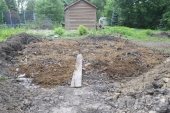So, I spent my afternoon today digging a 250 foot long swale. There's a story behind this, which I will tell. However, if you're in a hurry, you can scroll to the bottom to see the pictures and to see what advice I'm looking for.
The Story...
We live on 23 acres, and about 98% of it is hillside. Our house sits at the bottom of the hill. What this means during rainy times is that the whole hillside acts as one big water shed that sends all the surface runoff toward the house. As you probably guessed, we have problems with water penetration in our basement. Many moons ago, someone apparently tried to manage all of this water by digging a swale at a sloped angle across the hillside. I'm not sure what they were thinking, but they dug the swale in such a way that it collected the run off and sent it toward the house. This seemed like a bad idea to me. So, I decided to intercept the water from the old swale, and redirect it into a new swale so that it would run back across the slope, away from the house.
In addition to all of this, we just sheet mulched a 12,000 square foot area last fall for this year's garden. It just so happens that this garden area is located a short distance directly down slope from the swale. So, I'm hoping to utilize the plume effect with the swale so that any water it captures and hold will slowly percolate through the soil down into the garden and help us keep the garden soil moist. We'll see in time if that theory works or not.
Finally, I am head over heels in love with hugelkulture, so I decided to incorporate a big pile of rotting wood into a portion of this swale. The first 80 feet of the swale contains about 10 tons of rotting wood waste that a local arborist dropped of at my place. Before anyone goes crazy on me here, I want to say that I am aware of the warnings against putting hugel beds on the downhill side of a swale. There are sensible reasons for avoiding this strategy. Time may prove me a fool, but I am cautiously bypassing the warnings in the name of experimentation. I believe that I have constructed my beds and my swale in such a way as to minimize any risk of bad things happening from using this strategy. Just for the record, I usually approach projects cautiously, so going against sound advice on this matter is no light thing for me. I certainly will keep an eye on this hugel bed to watch for any destabilization or risk of soil slippage. So far, the bed has already weathered some heavy rains this winter and it hasn't budged at all. Seems pretty stable, but we'll see how it does now that I've added the new swale to the system.
The swale contains a couple inches of drop in the first 1/3 of the length in order to encourage the water to move away from my house. The remaining 2/3 are perfectly flat, according to my laser level. The swale dead-ends into a small collection pond, with an outlet to the downhill side where the pond overflows to let out water along my property line and down into the creek below. The theory I'm working on here is that I can reduce erosion and increase water saturation in the soil by slowing the movement of the water and holding onto it for a while in the swale and pond. Previous to digging this, there were little water runways carving up my hillside where water would run straight down the hill at rapid rates of speed. It cut some pretty deep ditches in the hillside. This swale is designed to halt that fast-moving water and turn it into slow-moving (virtually stationary) water that can be absorbed and used by plants.
I Need Your Advice
So, here's the part where I ask you fine permie folks for some input. I need help figuring out what to plant on/around the hugel bed. Presently, I'm favoring the idea of covering the soil with some clover and vetch to get some roots in it. Then I'd like to add some nut trees (e.g. chestnut, pecan, etc.), or possibly mulberry or paw paw or something along those lines. There are already quite a few walnut trees growing just uphill from the swale. I'm also considering the idea of putting this year's pumpkin plants on the bed. My thoughts about what to put on the bed change from day to day. The possibilities seem endless, so help me narrow things down to a few good selections.
Note: The hugel bed runs east/west, so the main surface area of the sides faces south and north. It has full sun exposure all day long. We are in zone 6b.









